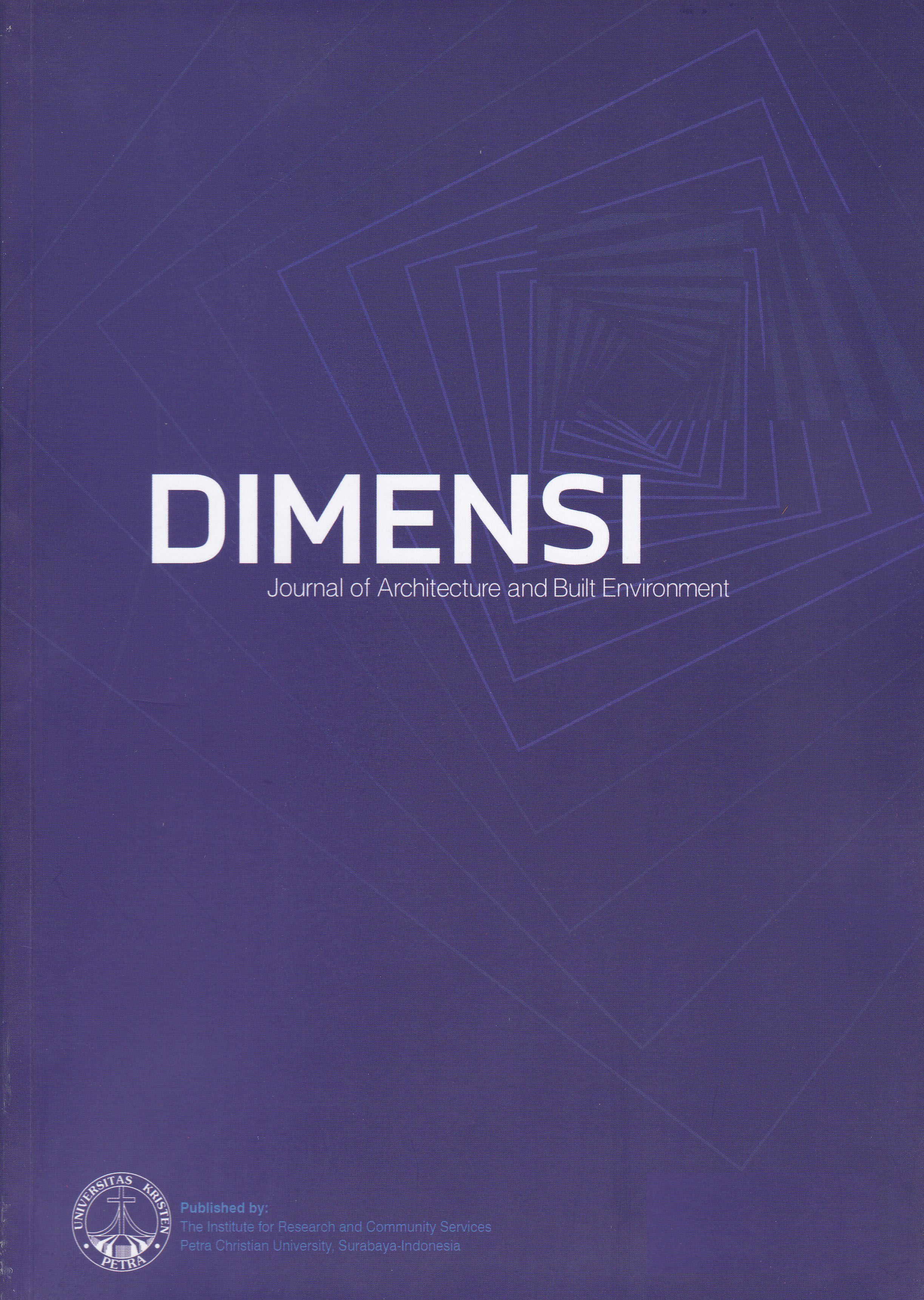FLEXIBLE HOUSING SCHEMES ON HOUSING TYPE 36 IN YOGYAKARTA
DOI:
https://doi.org/10.9744/dimensi.48.2.97-108Keywords:
Flexible housing, housing Type 36, YogyakartaAbstract
Flexible housing has the potential to be applied in housing type 36 in Indonesia, especially with a focus on the modeling of the flexible housing scheme. But beforehand, potential redundancies and trend patterns of occupant needs must be identified. The research stages are spaciousness, spatial complexity using statistics, and perceptual clarity using repeated modeling and evaluation. There are 28 research data samples taken from type 36 housing developed by Perum perumnas Regional V of Yogyakarta branches i.e. Perumnas Minomartani, Perumnas Condong Catur, Perumnas Guwosari, and Perumnas Trimulyo. The results of the research are change of rooms needs for the inhabitant, transformation of tipology from the house layout, the priority setting of rooms for the inhabitants, linkage among rooms that is efficient for the inhabitant, limitations of flexible housing, and flexible housing schemes.
Downloads
References
Albostan, D. (2009). Flexibility in Multi-Residential Housing Projects: Three Innovative Cases from Turkey. Published Magister Architecture Thesis, Middle East Technical University.
Altan H., Gasperini N., Moshaver, S., & Frattari, A. (2015). Redesigning Terraced Social Housing in the UK for Flexibility Using Building Energy Simulation with Consideration of Passive Design. Journal of Sustainability, 7, 5488-5507.
Building & Construction Authority Singapore. (2000) Modular coordination. BCA Buildability Series, Singapore.
Chaplin, J.P. (2002). Dictionary of Psychology. Dell Publishing Co. Inc., New York.
Ching, F.D.K. (1994). Architecture: Form, Space, and Order. John Wiley & Sons, Inc., USA.
Farrow R.J., Labrador, A.C., & Crews, J.D. (2012). Road to Flexibility: Strategic Interventions. Website https://www.healthcaredesignmagazine. com/trends/architecture/road-flexibility-strategic-interventions/, accessed on May 27, 2017.
Fawcett W., Hughes, M., & Ellingham, I. (2012). Quantifying the Benefits of Flexible Buildings. Proceedings of the conference Long Lasting Buildings in Urban Transformation, 146-153.
Franklin, B. (2006). Housing Tranformations: Shaping the Space of Twenty-First Century Living. Routledge, New York.
Frisky, H., & Pramitasari, D. (2018). Skema Flexible Housing pada Perumahan tipe 36 di Yogya¬karta. Unpublished Magister Architecture Thesis, Universitas Gadjah Mada.
Frisky, H., & Pramitasari, D. (2018). Flexible Housing: Architectural Investment for Future House. The Proceedings of 12th SEATUC Symposium: Engineering Education and Research for Sustainable Development, 14 & 70-80.
Gilani, G. (2012). Evaluating Flexibility Notions in Mass Housing of North Cyprus through Learning from Her Rural Vernacular Architecture. Published Magister Architecture Thesis, Eastern Mediterranean University.
Gosling J. (2008). Flexible buildings for an adaptable and sustainable future. Proceedings of 24th Annual ARCOM Conference, 115-124.
Groat, L.N., & Wang, D. (2013). Architectural Rese-arch Methods, Second Edition. John Wiley & Sons, Inc., Canada.
Iswati, T.Y. (2001). Perubahan Denah Rumah Tinggal di Kampung Dalam Yogyakarta. Unpublished Magister Architecture Thesis, Universitas Gadjah Mada.
Keputusan Menteri Pekerjaan Umum dan Perumahan Rakyat No. 552/KPTS/M/ 2016 about Batasan Penghasilan Kelompok Sasaran KPR Bersubsidi, Batasan Harga Jual Rumah Sejahtera Sejahtera Tapak dan Satuan Rumah Sejahtera Susun, Serta Besaran Subsidi Bantuan Uang Muka Perumah-an, Keputusan Menteri Permukiman dan Prasarana Wilayah No. 403/KPTS/M/ 2002 about Pedoman Teknis Pembangunan Rumah Sederhana Sehat (Rs Sehat).
Kristiani, L. (1996). Perubahan Tata Ruang Banguan ‘Rumah Usaha’ di Prawirotaman Yogyakarta. Unpublished Magister Architecture Thesis, Uni-versitas Gadjah Mada.
Li, S. (2014). A View of Flexible Housing in China. International Journal of Social, Behavioral, Edu-cational, Economic, Business and Industrial Engi¬neering, 8(4), 958-962.
Nugroho, P.S. (2002). Studi Perubahan Spasial Rumah Tinggal menjadi Rumah Pondokan Mahasiswa di Yogyakarta. Unpublished Magister Architecture Thesis, Universitas Gadjah Mada.
Pamungkas, L.S. (2005). Tipologi Perubahan Spasial Rumah Tinggal Pra Huni (Timoho Asri V, Yogyakarta). Unpublished Magister Architecture Thesis, Universitas Gadjah Mada.
Peraturan Menteri PUPR No. 21/PRT/M/2016 about Kemudahan dan/atau Bantuan Perolehan Rumah Bagi Masyarakat Berpenghasilan Rendah.
Schnädelbach, H. (2010). Adaptive Architecture - A Conceptual Framework. Research Gate confe-rence paper.
Schneider, T., & Till, J. (2005). Flexible housing: opportunities and limits. Journal of Arq, 9(2), 157-166.
Schneider, T., & Till, J. (2005). Flexible housing: the means to the end. Journal of Arq, 9(3), 287-196.
Schneider, T., & Till, J. (2007). Flexible Housing. Routledge, New York.
Siregar, J.P. (2014). Metodologi dasar space syntax dalam analisis konfigurasi ruang. Universitas Brawijaya, Jakarta.
Sugini. (1997). Morfologi Perubahan Rumah pada Perumahan Minomartani Yogyakarta. Unpublished Magister Architecture Thesis, Universitas Gadjah Mada.
Till, J. (2008). Soft Space. University of Sheffield, Inggris.
Undang-Undang Republik Indonesia No. 1 tahun 2011 about Perumahan Dan Kawasan Permukiman.
Yu, J.G. (2011). American Dream 3.0: Flexible Urban Housing for Changing Life-styles. Unpublished Magister Architecture Thesis, University of Maryland.
Yudhohusodo, S. (1991). Rumah untuk Seluruh Rak-yat. Bangun Cipta Pratama, Jakarta.
Živković, M., & Jovanović, G. (2012). A Method for Evaluating the Degree of Housing Unit Flexibility in Multi-Family Housing. Journal of Architecture and Civil Engineering, 10(1), 17-32.
Downloads
Published
How to Cite
Issue
Section
License
Authors who publish with this journal agree to the following terms:
- Authors retain copyright and grant the journal right of first publication with the work simultaneously licensed under a Creative Commons Attribution License that allows others to share the work with an acknowledgement of the work's authorship and initial publication in this journal.
- Authors are able to enter into separate, additional contractual arrangements for the non-exclusive distribution of the journal's published version of the work (e.g., post it to an institutional repository or publish it in a book), with an acknowledgement of its initial publication in this journal.
- Authors are permitted and encouraged to post their work online (e.g., in institutional repositories or on their website) prior to and during the submission process, as it can lead to productive exchanges, as well as earlier and greater citation of published work (See The Effect of Open Access).



















